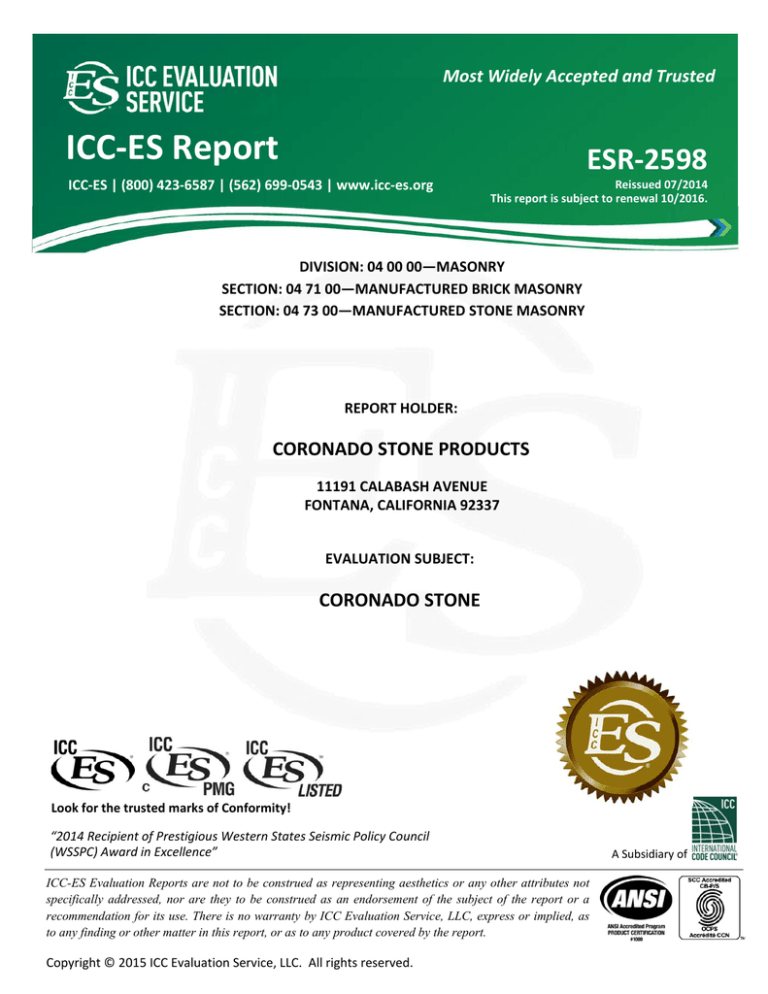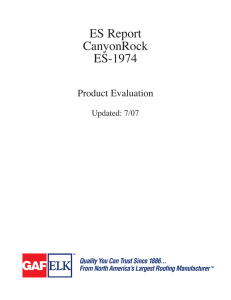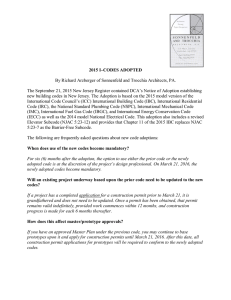
Most Widely Accepted and Trusted 0 ICC‐ES Report ESR‐2598
ICC‐ES | (800) 423‐6587 | (562) 699‐0543 | www.icc‐es.org
000 Reissued 07/2014
This report is subject to renewal 10/2016.
DIVISION: 04 00 00—MASONRY SECTION: 04 71 00—MANUFACTURED BRICK MASONRY SECTION: 04 73 00—MANUFACTURED STONE MASONRY REPORT HOLDER: CORONADO STONE PRODUCTS 11191 CALABASH AVENUE FONTANA, CALIFORNIA 92337 EVALUATION SUBJECT: CORONADO STONE Look for the trusted marks of Conformity! “2014 Recipient of Prestigious Western States Seismic Policy Council (WSSPC) Award in Excellence” ICC-ES Evaluation Reports are not to be construed as representing aesthetics or any other attributes not
specifically addressed, nor are they to be construed as an endorsement of the subject of the report or a
recommendation for its use. There is no warranty by ICC Evaluation Service, LLC, express or implied, as
to any finding or other matter in this report, or as to any product covered by the report.
Copyright © 2015 ICC Evaluation Service, LLC. All rights reserved.
A Subsidiary of ICC-ES Evaluation Report
ESR-2598*
Reissued July 2014
This report is subject to renewal October 2016.
www.icc-es.org | (800) 423-6587 | (562) 699-0543
DIVISION: 04 00 00—MASONRY
Section: 04 71 00—Manufactured Brick Masonry
Section: 04 73 00—Manufactured Stone Masonry
A Subsidiary of the International Code Council ®
instructions, and the applicable code. The manufacturer’s
published installation instructions must be available at the
jobsite at all times during installation.
The veneer may be applied over painted exterior stucco,
plywood or gypsum sheathing; open wood or steel studs;
or masonry walls. For interior applications, the veneer may
also be installed over plaster or gypsum wallboard.
REPORT HOLDER:
CORONADO STONE PRODUCTS
11191 CALABASH AVENUE
FONTANA, CALIFORNIA 92337
(909) 357-8295
www.coronado.com
4.2 Preparation of Backing:
4.2.1 Cement Plaster Backings: Cement plaster
backings may be applied over painted exterior stucco,
plywood, OSB or gypsum sheathing supported by wood or
steel studs; over open wood or steel studs; over concrete
walls; and over concrete masonry walls, when installed as
described in Sections 4.2.1.1 and 4.2.1.2.
EVALUATION SUBJECT:
CORONADO STONE
1.0 EVALUATION SCOPE
Compliance with the following codes:
2015 International Building Code® (IBC)
2015 International Residential Code® (IRC)
Other codes (see Section 8.0)
Properties evaluated:
Veneer strength and durability
Surface burning characteristics
2.0 USES
Coronado Stone is used as an adhered, nonload-bearing
exterior veneer or an interior finish and trim on walls of
wood stud or light-gage-steel stud construction or masonry
walls.
3.0 DESCRIPTION
The veneer is a precast concrete product made to
resemble natural stone or brick in color and in texture. The
concrete is composed of cement, aggregate, water,
admixtures and coloring. The veneer units are molded and
cured at the plant. The average saturated weight of the
installed veneer units does not exceed 15 pounds per
2
square foot (73.2 kg/m ). Recognized veneer styles are
listed in Table 1.
The veneer has a Class A finish rating in accordance
with IBC Section 803.1.1 and complies with the flamespread and smoke-development requirements of IRC
Section R302.9.
4.0 INSTALLATION
4.1 General:
Installation of Coronado Stone must comply with this
report,
the
manufacturer’s
published
installation
4.2.1.1 Installation
Over
Studs:
For
exterior
installations, the cement plaster backing must be installed
over a water-resistive barrier complying with IBC Section
1405.10.1.1 or IRC Section R703.12.3, as applicable. Also,
flashing must be installed as required by IBC Section
1405.10.1.2 or IRC Sections R703.4 and R703.12.2, as
applicable, and weep screeds must be installed at the
bottom of the stone veneer. The weep screeds must
comply with, and be installed in accordance with, IBC
Section 1405.10.1.2.1 or IRC Section R703.12.2, as
applicable. In addition, the weep screeds must have holes
3
with a minimum diameter of /16 inch (4.8 mm) spaced at a
maximum of 33 inches (838 mm) on center, as required by
Section 12.1.6.2 of TMS 402/ACI 530/ASCE 5, which is
referenced in IBC Section 1405.10. The veneer must be
installed with the clearances required by IBC Section
1405.10.1.3 or IRC Section R703.12.1, as applicable.
Studs must be spaced no more than 16 inches (406 mm)
on center, unless otherwise noted. Lath must be a 2.5 or
2
2
3.4 lb/yd (1.4 or 1.8 kg/m ), self-furring diamond metal lath
complying with ASTM C847 or a 1.4 lb/yd2 (0.760 kg/m2)
woven wire mesh complying with ASTM C1032. Lath may
be self-furred or non-furred, provided furring or furring
fasteners are used. When the cement plaster backing is
installed over open studs, a paper back lath must be used.
All lath and mesh must be installed over the water-resistive
barriers by following lath manufacturer's installation
guidelines and recommendations. Lath or mesh must be
fastened to each of the wall studs as required by ASTM
C1063 and IRC Section R703.7.1. Fasteners must be
spaced a maximum of 6 inches (153 mm) on center. Steel
studs may be spaced a maximum of 24 inches on center
3
(610 mm) provided the lath is corrosion-resistant, /8-inchhigh (9.5 mm), ribbed, expanded metal lath attached to the
steel studs at a maximum of 5 inches (127 mm) on center.
*Revised October 2015
ICC-ES Evaluation Reports are not to be construed as representing aesthetics or any other attributes not specifically addressed, nor are they to be construed
as an endorsement of the subject of the report or a recommendation for its use. There is no warranty by ICC Evaluation Service, LLC, express or implied, as
to any finding or other matter in this report, or as to any product covered by the report.
1000
Copyright © 2015 ICC Evaluation Service, LLC. All rights reserved.
Page 1 of 3
ESR-2598 | Most Widely Accepted and Trusted
For attaching lath to wood studs, fasteners must be
galvanized nails having a minimum shank diameter of
0.120 inch (3.06 mm), a minimum head diameter of
7
/16 inch (11.1 mm) and sufficient length to penetrate the
studs a minimum of 1 inch (25.4 mm). Wood studs must
have a minimum specific gravity of 0.42. For attaching lath
to steel studs, fasteners must be a corrosion resistant pan
head or pancake head #8 self-drilling, tapping screws
3
having sufficient length to protrude a minimum of /8 inch
(9.5 mm) through the stud. Steel studs must be a minimum
of 43 mils thick.
1
A /2-inch-thick (12.7 mm) scratch coat of Type S mortar
(cement plaster) complying with ASTM C926 is applied
over the metal lath or woven wire mesh, etched using a
trowel in accordance with the manufacturer’s published
installation instructions, and allowed to cure in accordance
with IBC Section 2512.6, prior to application of the veneer
units.
4.2.1.2 Installation over Concrete and Masonry: The
veneer units may be applied directly to concrete and
masonry backing without lath, provided the concrete and
masonry surface is clean. Where lath is used, it must be
corrosion-resistant metal lath complying with ASTM C847,
or 1.4 lb/yd2 (0.760 kg/m2), corrosion-resistant, woven wire
plaster base complying with ASTM C1032. The lath must
be fastened to the wall in accordance with Section 7.10 of
ASTM C1063, and IRC Section R703.7.1, as applicable.
The fasteners must be spaced a maximum of 6 inches
(152 mm) on center vertically and 16 inches (406 mm) on
center horizontally. The gravity load (shear) capacity and
negative wind load (pull-out) capacity of the proprietary
fasteners must be justified to the satisfaction of the code
official. The scratch coat must be applied as described in
Section 4.2.1.1.
4.2.2 Masonry Backing:
The veneer units may be applied directly to masonry
backings, without the use of lath, provided the surface is
clean. Painted, waterproofed or dirty masonry surfaces
must be cleaned by sandblasting or other means to
provide a good bond surface.
4.3 Application of Veneer Units:
Cement plaster backings must be moistened in
accordance with the veneer manufacturer’s published
installation instructions. Veneer units must be installed in
accordance with IBC Section 1405.10.1.4.3. Under the
1
3
IRC, a coat of Type S mortar, /2 inch to /4 inch thick (12.7
to 19.1 mm), is applied to the moistened scratch coat in
areas of approximately 10 square feet (0.929 m). The
combined thickness of the scratch coat and mortar setting
bed must be a minimum of 7/8 inch (22 mm). As an
alternate to applying the mortar setting bed to the scratch
coat, the mortar setting bed may be applied to the back of
each piece of veneer and the veneer gently worked in
place over the scratch coat. The mortar bed consistency
must be such as to allow mortar to be squeezed around all
edges of the veneer unit to assure full bond. Joints
between veneer units must be grouted and tooled in
accordance with the veneer manufacturer’s published
installation instructions.
5.0 CONDITIONS OF USE
The manufactured Coronado Stone veneer described in
this report complies with, or is a suitable alternative to what
is specified in, those codes listed in Section 1.0 of this
report, subject to the following conditions:
5.1 Installation must comply with this report, the
manufacturer’s published installation instructions and
Page 2 of 3
the applicable code. In the event there is a conflict
between the manufacturer’s published installation
instructions and this report, this report governs.
5.2
The use of the manufactured stone veneer has been
evaluated for installation on walls with cement plaster
or masonry backings.
5.3 Expansion or control joints used to limit the effect of
differential movement of precast stone veneer
supports must be specified by the architect, designer
or veneer manufacturer, in that order. Consideration
must also be given to movement caused by
temperature change, shrinkage, creep and deflection.
5.4 In jurisdictions adopting the IBC, the supporting wall
construction must be designed to support the weight
of the veneer system, including veneer, setting bed
and cement plaster backing, as applicable.
Additionally, horizontal framing members, at wall
openings such as lintels and headers, that support the
precast stone veneer must be designed to limit
deflection to 1/600 of the span of the supporting
members.
5.5 In jurisdictions adopting the IRC, where the seismic
provisions of IRC Section R301.2.2 apply, the
average weight of the wall supporting the precast
stone veneer, including the weight of the veneer
system, must be determined. If the average weight
exceeds the applicable limits of IRC Section
R301.2.2.2.1, or for buildings in Seismic Design
Category E, an engineered design of the wall
construction must be performed in accordance with
IRC Section R301.1.3.
6.0 EVIDENCE SUBMITTED
6.1 Data in accordance with the ICC-ES Acceptance
Criteria for Precast Stone Veneer (AC51), dated June
2013 (editorially revised September 2014).
6.2 Data in accordance with ASTM E84 as an interior
finish.
7.0 IDENTIFICATION
Each package of veneer is labeled or stamped with the
Coronado Stone Products name and address, the product
name, the date of manufacture and the evaluation report
number (ESR-2598).
8.0 OTHER CODES
8.1 Evaluation Scope:
In addition to the codes referenced in Section 1.0, the
products described in this report were evaluated for
compliance with the following codes:
®
2012 International Building Code (2012 IBC)
®
2012 International Residential Code (2012 IRC)
2009 International Building Code® (2009 IBC)
2009 International Residential Code® (2009 IRC)
2006 International Building Code® (2006 IBC)
2006 International Residential Code® (2006 IRC)
The Coronado Stone products described in this report
comply with, or are suitable alternatives to what is
specified in, the codes listed above, subject to the
provisions of Sections 8.2 through 8.7.
8.2 Uses:
See Section 2.0.
ESR-2598 | Most Widely Accepted and Trusted
Page 3 of 3
8.3 Description:
See the first two paragraphs of Section 3.0 and the
following: The veneer has a Class A finish rating in
accordance with 2012 and 2009 IBC Section 803.1.1 (2006
IBC Section 803.1) and complies with the flame-spread
and smoke-development requirements of 2012 and 2009
IRC Section R302.9 (2006 IRC Section R315).
8.4 Installation:
8.4.1 General: See Section 4.1, and the following: Under
the 2012 IBC and 2012 IRC, the veneer must be installed
in accordance with the clearance requirements of 2012
IBC Section 1405.10.1.3 and 2012 IRC Section R703.12.1,
as applicable.
8.4.2 Preparation of Backing:
must be installed at the bottom of the stone veneer. The
weep screeds must comply with, and be installed in
accordance with, 2012 IBC Section 1405.10.1.2; 2009 and
2006 IBC Section 2512.1.2; 2012 IRC Section R703.12.2;
or 2009 and 2006 IRC Section R703.6.2.1, as applicable.
In addition, the weep screeds must have holes with a
minimum diameter of 3/16 inch (4.8 mm) spaced at a
maximum of 33 inches (838 mm) on center, as required by
Section 6.1.6.2 of TMS 402-11, which is referenced in
2012 IBC Section 1405.10; Section 6.1.5.2 of TMS 402-08,
which is referenced in 2009 IBC Section 1405.10; or
Section 6.1.5.2 of ACI 530-05, which is referenced in 2006
IBC Section 1405.9, as applicable.
8.4.2.1.2 Installation
4.2.1.2.
over
Masonry:
See
Section
8.4.2.1 Cement Plaster Backings: See Section 4.2.1.
8.4.2.2 Masonry Backing: See Section 4.2.2.
8.4.2.1.1 Installation over Studs: See Section 4.2.1.1,
except replace the first paragraph of Section 4.2.1.1 with
the following: For exterior installations, the cement plaster
backing must be installed over a water-resistive barrier
complying with 2012 IBC Section 1405.10.1.1; 2009 and
2006 IBC Sections 1404.2 and 2510.6; or 2012, 2009 and
2006 IRC Sections R703.2 and R703.6.3, as applicable.
Also, flashing must be installed as required by 2012
Sections 1405.4 and 1405.10.1.2; 2009 IBC Section
1405.4; 2006 IBC Section 1405.3; or 2012, 2009 and 2006
IRC Section R703.8, as applicable, and weep screeds
8.4.3 Application of Veneer Units: See Section 4.3.
8.5 Conditions of Use:
See Section 5.0.
8.6 Evidence Submitted:
See Section 6.0.
8.7 Identification:
See Section 7.0
TABLE 1—RECOGNIZED VENEER STYLES
3” Split Limestone
Eastern Mountain Ledge
Pro-Ledge
8” Classic Jerusalem
English Rubble
Quick Stack
Adobe Brick
Euro Villa
River Rock
Aegean Coral
Feathered Stone
Rocky Mountain Ledge
Appalachian Fieldstone
French Country Villa
Sand Canyon Flagstone
Belgian Brick
French Limestone
Santa Barbara
Belgian Castle
The Getty Stone
Sculptured Brick
Canyon Cobble
Idaho Drystack
Sierra Ledge
Canyon Ledge
Italian Villa
Smooth Limestone
Caribbean Coral
Lennox Stone
Split Fieldstone
Carolina Rubble
Minnesota Fieldstone
Tumbled Ledge
Chiseled Limestone
Montana Ledge
Tuscan Villa
Clinker Brick
Mountain Strip Stone
Valley Cobble
Colosseum Travertine
Mountain Villa
Venetian Villa
Coronado Honey Ledge
Old Country Ledge
Virginia Ledge
Coronado Strip Stone
Old World Ledge
Weathered Edge
Country Castle
Osage
Woodstone
Country Rubble
Pavilion Stone
Yukon Rubble
Creek Rock
Playa Vista Limestone
Desert Ridge
Princeton Granite




